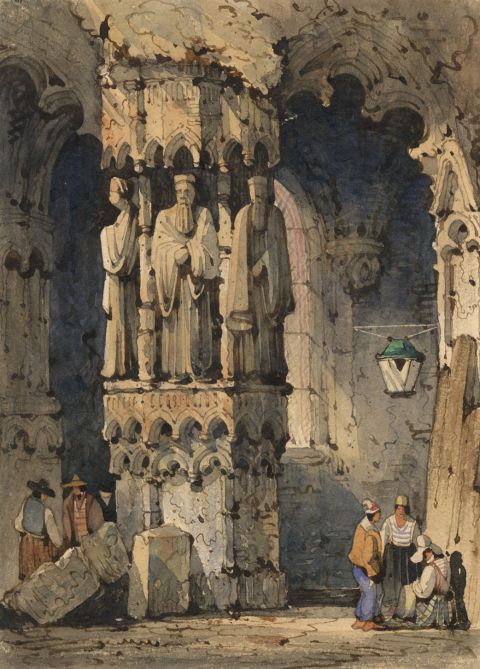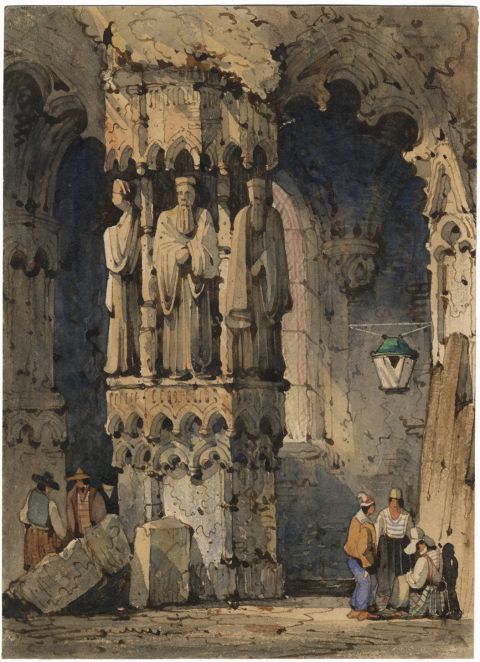This website uses cookies to ensure you get the best experience on our website. Learn more.
Attrib. Samuel Prout OWS, Cathedral Ruins, Rouen –early 19th-century watercolour
Collection: Sir William Vernon Guise Collection
An original early 19th-century watercolour painting, Attrib. Samuel Prout OWS, Cathedral Ruins, Rouen, France.
This fine topographical watercolour displays the distinctive precision and flair of Samuel Prout (1783–1852), one of the masters of British watercolour architectural painting, who was Painter in Water-Colours in Ordinary to King George IV, 1829, and afterwards to Queen Victoria.
The elaborate tracery and monumental statues of the extant cathedral at Rouen are cast in dramatic light, with figures gathered characteristically in the foreground, their unfamiliar regional costumes bringing local flavour to the scene. Prout first travelled to Normandy and up the Seine in 1819, on holiday from Dr Glennie's Academy. He exhibited the resulting pictures at the Society of Painters in Water-Colours in Bond Street in 1820 and Rouen with its many old buildings was the richest of his subjects.
Prout remained steadfast in his commitment to topographical watercolours and the depiction of architecture, treating the subject with a Romanticism akin to that of his landscape artist contemporaries. Describing ecclesiastical buildings in 'Sketches at Home and Abroad' (1844) he says: 'they are landmarks of the inheritance of our forefathers; every stone, to a reflective mind, awakens thoughts which ennoble and instruct, impressing the soul with lofty feelings. They are temples, beautiful in death, and well suited for the devotion of an enthusiastic artist.’
Provenance: from an album of drawings associated with Sir William Vernon Guise, 4th Baronet (1816–1887) and his circle.
In watercolour with pen and ink.
All artworks come with a Certificate of Authenticity and—if it is a collection artwork—its accompanying collection text or artist biography.
Details
Signed: No.
Inscribed: Inscribed verso 'Rouen' and on a separate accompanying fragment of paper 'Prout'.
Condition: In very good condition for its age, with just the odd, barely visible, tiny abrasion to the paper surface. There are historic adhesive marks and paper remnants to periphery verso, from previous mounting. Some creasing to the accompanying paper inscription. Please see photos for detail.
Presented: Unframed.
Sir William Vernon Guise Collection
Samuel Prout (1783–1852) was born at Plymouth, and spent his youth sketching the rustic cottages and bridges of rural Devon. In 1803 he moved to London, where he earned a living painting marine pieces for Palser the printseller and was one of the first to use lithography. In 1819 he became a member of the Old Watercolour Society, and the same year, he undertook the first of numerous sketching tours to the Continent. From this time on, Prout found his niche, depicting the picturesque streets and buildings of France, Germany, Italy and the Netherlands. His resulting atmospheric watercolours of picturesque architecture were highly popular and influential, widely reproduced as lithographic illustrations and enjoying the high praise of John Ruskin. His work is represented in numerous public collections, including the British Museum, Courtauld Gallery, Tate and V&;A; The Fitzwilliam Museum, Cambridge; Manchester Art Gallery; Plymouth City Museum and Art Gallery.
View the full collection Sir William Vernon Guise Collection




